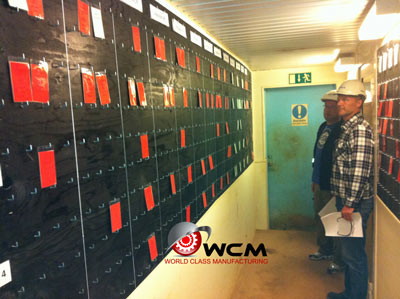
Seiketsu is the fourth step of the 5S method. It means "standardized cleanup". It derives from the one-time Seiso step which made the factory "shiny clean" and set the standard for cleanliness. Seiketsu makes it possible and feasible to live up to that standard.

This article introduces Seiketsu; the next article will provide more detail on how to do it.
Seiketsu enables and ensures compliance to the new standards of cleanliness. The benefits include:
One output from the Seiso step was a list describing the cleanup process:
We also found repair and maintenance issues, and began to ask "Where does the dirt come from"?
As an overview, four main questions will provide the answer:
Many 5S consultants suggest that Seiketsu should include standardizing more than just the cleanup tasks. They suggest that both Seiri ("sort") and Seiton ("set in order") need the same discipline.
That is true, but it is also a question of "what is included in Seiketsu"? Deciding which rack should hold a particular tool part of Seiton. If that tool is improperly left on a workbench, is that a violation of "setting in order" or of "cleanliness, including tidiness"? If the tool is stored in the correct rack, but caked with grease and dust – which principle is being violated?

The previous article introduced Seiketsu. This article will discuss "how to" standardize cleanup processes to maintain the Seiso standard of cleanliness.
From the Seiso step, we have the following information about the cleanup process, or we have begun to list questions that require investigation:
Let's return to the example of sawdust (or metal filings) produced by a cutting operation. The pile of sawdust was identified as "dirt", to be cleaned daily with a broom.
Could this step be eliminated? Could the sawdust be captured during the cutting operation? Would a vacuum "fume hood" be powerful enough to draw the sawdust directly to a barrel? What about attaching a bag, like one used on lawn mowers to catch grass clippings?
It goes without saying that repairing faulty equipment – such as leaking seals or hoses – is also a way to prevent a mess from starting.
Each worker should have a set of daily cleanup tasks. These tasks may include:
This set of actions should not add more than about five minutes to each worker's set of routine daily tasks. One key is that this becomes the routine.
For management to enforce the standards, the standards need to be documented. Since managers actively helped in the one-step Seiso process, the photographs of the tidy workplace should be sufficient.

It takes a bit more planning and organizing to ensure that weekly tasks are fully completed. Develop a binder for each work area, with clear instructions explaining these duties. Use a checklist to log who did each cleanup task. Follow up with a visual inspection of the task area, and by checking that the checklist has been signed.
Beyond the weekly horizon, the less frequent tasks require more attention and planning.
Like the weekly task system, this group needs a list of tasks and instructions, plus a checklist or logbook. In addition, it needs a scheduling system to ensure the tasks are accomplished on time.
The scheduling system may be set up on a computer. It could be as simple as a calendar in each work area, to remind workers when the cleaning tasks should be performed.
This also requires delegating a person to ensure the schedule is planned and followed.
Seiketsu standardizes cleanup: several successful repetitions are needed to make a change into a standardized habit. Daily and weekly tasks quickly become routine. Because of the time which elapses between the infrequent cleanup tasks, it will take longer to make them habitual and repeatable. Therefore it is vital to develop a system that works for your organization. Management should make these infrequent cleaning tasks into deliverables and inspect the results until satisfied that the change is habitual. You don't want to open a cabinet or move a machine and find a built-up mess that should have been addressed regularly.
What are the benefits of Seiketsu in the 5S process?
There are good reasons for companies to spend significant time and money on "image": to design a logo, a colour scheme, and the font(s) which are used in advertising and on letterhead. One reason is "brand recognition" – the customer should instantly recognize the brand.
Consider developing standardized labels for tools and tool storage:
The idea is that any worker should be able to recognize a "tool label", even on unfamiliar tools. The label might help indicate where it should be stored (in which department's tool rack), or for what purpose (metric or imperial products).
Use consistent signage – all "exit" signs look the same, but are different from "entry" signs or "washroom" signs – to make the message easy to understand quickly. Some of this has been built into society: the red circle with a slash to indicate "do not go here or do this"; skull and crossbones labels for poisons. Find ways to extend the use of standard colours and images to convey important information quickly and consistently. The main benefit here is increased workplace safety.
By Oskar Olofsson, author of the book "Succeeding with 5S"
Enhance your 5S implementation and sustenance with our intuitive new app. It offers:
The app is developed by Oskar Olofsson, a renowned Lean expert and acclaimed author of "Succeeding with 5S". Harness the power of Lean management at your fingertips!


Succeeding With Lean Leadership

Succeeding With 5S

Succeeding With Standardized Work